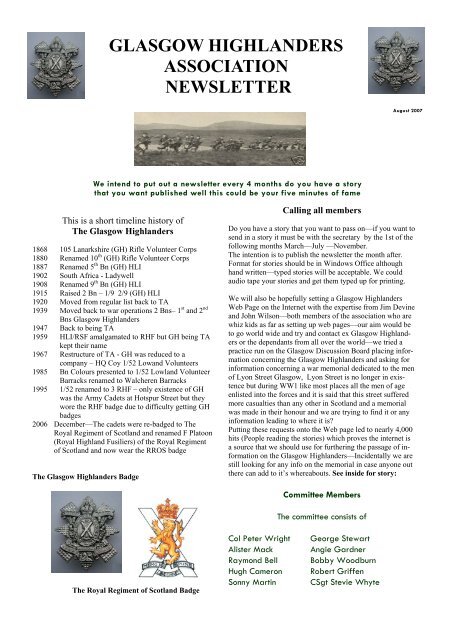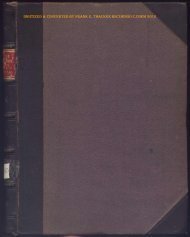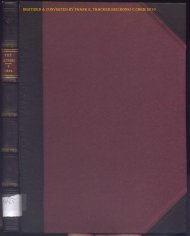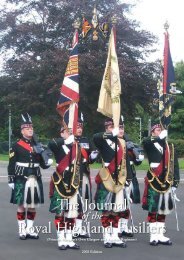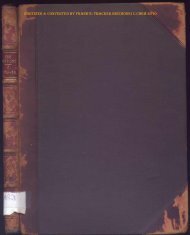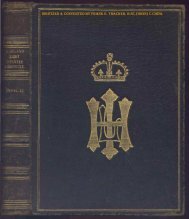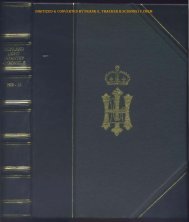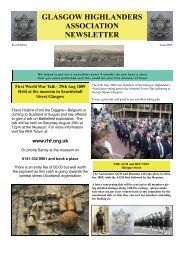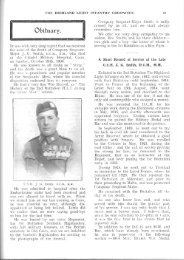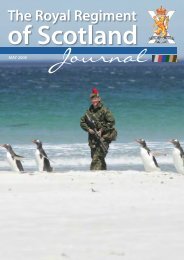Newsletter No1 - August 2007 - The Royal Highland Fusiliers
Newsletter No1 - August 2007 - The Royal Highland Fusiliers
Newsletter No1 - August 2007 - The Royal Highland Fusiliers
Create successful ePaper yourself
Turn your PDF publications into a flip-book with our unique Google optimized e-Paper software.
GLASGOW HIGHLANDERSASSOCIATIONNEWSLETTER<strong>August</strong> <strong>2007</strong>We intend to put out a newsletter every 4 months do you have a storythat you want published well this could be your five minutes of fameThis is a short timeline history of<strong>The</strong> Glasgow <strong>Highland</strong>ers1868 105 Lanarkshire (GH) Rifle Volunteer Corps1880 Renamed 10 th (GH) Rifle Volunteer Corps1887 Renamed 5 th Bn (GH) HLI1902 South Africa - Ladywell1908 Renamed 9 th Bn (GH) HLI1915 Raised 2 Bn – 1/9 2/9 (GH) HLI1920 Moved from regular list back to TA1939 Moved back to war operations 2 Bns– 1 st and 2 ndBns Glasgow <strong>Highland</strong>ers1947 Back to being TA1959 HLI/RSF amalgamated to RHF but GH being TAkept their name1967 Restructure of TA - GH was reduced to acompany – HQ Coy 1/52 Lowand Volunteers1985 Bn Colours presented to 1/52 Lowland VolunteerBarracks renamed to Walcheren Barracks1995 1/52 renamed to 3 RHF – only existence of GHwas the Army Cadets at Hotspur Street but theywore the RHF badge due to difficulty getting GHbadges2006 December—<strong>The</strong> cadets were re-badged to <strong>The</strong><strong>Royal</strong> Regiment of Scotland and renamed F Platoon(<strong>Royal</strong> <strong>Highland</strong> <strong>Fusiliers</strong>) of the <strong>Royal</strong> Regimentof Scotland and now wear the RROS badge<strong>The</strong> Glasgow <strong>Highland</strong>ers BadgeCalling all membersDo you have a story that you want to pass on—if you want tosend in a story it must be with the secretary by the 1st of thefollowing months March—July —November.<strong>The</strong> intention is to publish the newsletter the month after.Format for stories should be in Windows Office althoughhand written—typed stories will be acceptable. We couldaudio tape your stories and get them typed up for printing.We will also be hopefully setting a Glasgow <strong>Highland</strong>ersWeb Page on the Internet with the expertise from Jim Devineand John Wilson—both members of the association who arewhiz kids as far as setting up web pages—our aim would beto go world wide and try and contact ex Glasgow <strong>Highland</strong>ersor the dependants from all over the world—we tried apractice run on the Glasgow Discussion Board placing informationconcerning the Glasgow <strong>Highland</strong>ers and asking forinformation concerning a war memorial dedicated to the menof Lyon Street Glasgow, Lyon Street is no longer in existencebut during WW1 like most places all the men of ageenlisted into the forces and it is said that this street sufferedmore casualties than any other in Scotland and a memorialwas made in their honour and we are trying to find it or anyinformation leading to where it is?Putting these requests onto the Web page led to nearly 4,000hits (People reading the stories) which proves the internet isa source that we should use for furthering the passage of informationon the Glasgow <strong>Highland</strong>ers—Incidentally we arestill looking for any info on the memorial in case anyone outthere can add to it’s whereabouts. See inside for story:Committee Members<strong>The</strong> committee consists of<strong>The</strong> <strong>Royal</strong> Regiment of Scotland BadgeCol Peter WrightAlister MackRaymond BellHugh CameronSonny MartinGeorge StewartAngie GardnerBobby WoodburnRobert GriffenCSgt Stevie Whyte
GLASGOW HIGHLANDERSNemo Me Impune LacessitFUNCTIONSFUNCTIONSWe have had two very successful functions since we reformed—one being held in the RHF Home museum in SauchiehallStreet Glasgow in May and the Family BBQ held at Walcheren Barracks Glasgow in June <strong>2007</strong>.Up to 60 members and friends attended each of these functions—SO WELL DONE TO ALL THOSE WHO ATTENDEDAGM<strong>The</strong> Association will hold it’s Annual General Meeting in the WO’s & Sgt’s Mess at Hotspur Street on a Tuesday evening inOctober <strong>2007</strong> starting at 2000hrs—All members attending must be seated in the mess ready for the meeting to start for2000hrs—Dress Suits—Shirt—Tie. A letter for the meeting has been sent. Anyone wishing to raise any points for the AGMare to submit their points with their return.REUNION<strong>The</strong> reunion will take place in the mess in October <strong>2007</strong>—Again a letter has been sent concerning this event—Returns to besent to Robert Woodburn along with payment—Cheques to be made out to“<strong>The</strong> Glasgow <strong>Highland</strong>ers Association”Details are in the letterAbout the <strong>Newsletter</strong>We intend to issue this and give you the reader the opportunity to put your stories across to other readers—<strong>The</strong> plan isthat the front page will cover items like history or points that require to be highlighted to members—the centerfolds (??)would be stories from the members ie YOU and the rear page would generally be dedicated to things that can be lookedat using the Web (WWW). <strong>The</strong> web section will not change much but we will have a small section dedicated to anythingwe discover ie a new site to visit that could be of interest to members. Remember it should be a newsletter for the memberswritten by the members so it is your contribution that is important to keep it going!<strong>The</strong> <strong>Newsletter</strong> would be sent out on a four monthly interval—April—<strong>August</strong>— December. Anyone wanting to put somethingfor the newsletter are asked to submit their stories by 1st March—July—November to give us time to get them intothe next edition.Items can be sent as Emails or Microsoft Word format or indeed can be hand written/typed or we can arrange for anaudio interview and we would then type it up for you. If you had any photographs they can be originals or in any electronicformat—originals photographs would be returned.Items sent by Email can be directed to dinger105@hotmail.comWHERE’S YOUR STORY?As we said this is your chance to put your story into your newsletter—to get us started I have put in a story of the searchfor a memorial that was commissioned to honour the men of a little street which has since been taken off the map—thestreet was called Lyon Street which used to run parallel with Raglan Street. <strong>The</strong> stones in the playground are all that is leftof this street and have recently been fenced off for two reasons—one to save the local kids from damaging them and tostop any children hurting themselves. <strong>The</strong> story of the memorial was first brought to me about 5 years ago when I wasserving with the TA at Hotspur Street, I was asked by my adjutant to assist a lady called Liz in her search to track downthe whereabouts of the memorial—it has lead to many different stories being told about the street and it appears that themen of Lyon Street were a hard bunch who worked hard and played hard that even the police were wary of entering thestreet. I have a couple of old newspaper clippings concerning the street and I am wanting to continue to help in the searchfor the memorial—it appears to be about 3 ft by 4 ft in size thought to be carved in wood. Liz who works at St Joseph’sPrimary School would love to find out what happened to it—an outline story is on page three—interesting reading!If you read the story and can help Liz—Give me a call or drop me a line—Dinger105@hotmail.comPage 2
GLASGOW HIGHLANDERSNemo Me Impune Lacessit<strong>The</strong> Men of Lyon Street—A MemorialIf you travel on the Garscube Road heading towards thetown just as you pass St Georges Road look to your rightyou will see a football pitch—look beyond the pitch andyou will see the playground of St Joseph’s PrimarySchool . In the playground are a small group of masonrystones that have a small fence around them—these areall that remain of what used to be Lyon Street, a longgone street which disappeared as part of the redevelopmentof the area from 1960 to the late 80’s.Lyon Street bred it’s ownhero’s, for during the periodof the first world war mostof the men of enlistment agejoined the forces to fightGermany, it is believed thatthis street suffered morecasualties than any otherduring this period of war.In honour of these men amemorial was made by alocal craftsman– this memorial found it’s home in one ofthe local pubs—Keirens or the Milestone and on ArmisticeDay the memorial would be taken from the pub and paradedalong the street to allow the street to rememberthe actions of their men. Maryhill Barracks would send apiper and bugler along to play the lament at 11 O’clock—Flowers o the Forrest with the bugler playing <strong>The</strong> LastPost. This parade continued as far as I know up to1939—due to another conflict (WW2) then afterwardsup till the late 1950’s—after the parade the memorialwould be returned to the pub. As would the piper andbugler along with the locals.During the 2 minutes silence the local school kids of StJoseph’s would stop lessons—remain at their seats—puttheir pencils down and rest their heads on their arms ontop of the desk to observe the silence in order that theypay their respects.In the period of the 60’s—80’s the area was underdevelopment and the pub was demolished and thememorial appears to have been moved to St Joseph’sChapel for safety but the chapel too was demolishedand the whereabouts of the memorial is amystery.It was thought that the chapelremoved it into storage butspeaking to the priest atHopehill Road it appearsnot—he recons it was neverput into the chapel, anotherthought is that it was given toeither the Peoples Palace orRegimental Museum of the<strong>Royal</strong> <strong>Highland</strong> <strong>Fusiliers</strong>—both have been asked butwith no results. <strong>The</strong> next path to follow was, thatwhen it’s final home was raised to the ground it wastaken by the Brewers and it is said that it may beeither in the foyer or the boardroom of the Breweroffice—But, who were the brewers in the area at thetime?—I believe that there were many small breweriesoperating in the area many of whom have disappearedjust like the memorial.In the search a lady who works at St Joseph’s andhas spent much of her free time including her ownholiday time over the years searching for the originalmemorial has arranged that a plaque be commissionedto remember these men—the plaque wasunveiled two years ago in the school and a smallerversion passed to the locallibrary which is displayed atthe war book section in thelibrary to remind those whovisit the library that the men ofLyon Street made their markon the area. <strong>The</strong> plaque’s inthe school and library do notcontain the names or the informationcontained on the originalbut lists a poem written tohonour these men in 1917. <strong>The</strong>reason is that we do not knowwhat was written on the original,as all we have is a wellworn newspaper photograph clipping shown hereDO YOU KNOW ANYONE WHO CANHELP IN THE SEARCHPage 3
Shock and Awe! <strong>The</strong>se are the words recently used during the present day conflict in Iraq, but they musthave been the description associated with the situation that met the young men who dealt with the FirstWorld War during the battles of Ypres Salient 1914-1918.I took time out to visit the area where these soldiers fought a war that was supposed to end all wars, initiallyin 1914 these soldiers thought they were off to show the Boche a thing or two and would be backhome by Christmas but it proved that was not to be the case. Many volunteered because they felt that theydid not want to miss out in a great adventure.<strong>The</strong> Core Values of the British Army are:Selfless CommitmentCourage both moral and physicalDisciplineIntegrityLoyaltyRespect for othersDuring our four day tour we came across many cases of soldiers honouring these Core Values to the full.Day OneSHOCK AND AWEWe arrived at Ypres main square and were given the opportunity of visiting a beautiful elegant buildingknown as the Cloth Hall which had been completely destroyed by German Artillery during the First WorldWar, later fully restored to its former state, this building now houses a museum.“In Flanders Field Museum” the museum displays the story of the events of the time, it is then that it firstgave us an understanding of what the Core Values meant and it was the start of the listening process to hearhow the war came about and the condition that these soldiers would find themselves in. That was my firstintroduction of Shock and Awe! From their time!<strong>The</strong> museum is well laid out as you zigzag from displays, you learn from the build up to war and as the warprogressed and the devastation to man and the Belgian country.<strong>The</strong> Cloth Hall (top Left) devastated by enemy artilleryAlong with the rest of the townRestored - today
After leaving the Cloth Building we visited St Georges Church, a small church just off the main squarehosting many plaques of either regiments or individuals involved in the four year conflict, it was here that Imet a young English school child clutching a printout giving him details of his great grandfather whoserved with an English Rifle Regiment, I noticed the print out as one from the Commonwealth WarGraves Commission and I asked him who he was trying to find and on looking at it I said I had just readthat name of a plaque on the back of a bench a few rows away, and to see that young lads face to discoverthat his relative was listed was an amazing sight as he called to his school mates and teachers to show offhis discovery.We left the church to meet up with our main guide a Major Martyn Ashley-Taylor who was to be a mineof information on the battles of the time, his grandfather had served as a platoon commander and he readextracts from his grandfathers war diary on many occasions during his lectures and briefings, he came froma military family and he had left the army some five years ago and was now a barrister doing the battlefieldtours as a hobby which as the tour went on showed just how he enjoyed the chance of revisiting and speakingabout the soldiers and the battles and hardships they endured. At this point we were given a small crosswith a poppy attached being told that we could place this remembrance cross on any location we wouldvisit over the tour the choice would be ours as an individual token to these fallen soldiers.A quick coach trip saw us at Bedford House – which was an aid post during the war it was here that wereceived our introduction to Battlefield Cemeteries and HospitalCemeteries – obviously Hospital Cemeteries contained the soldierswho died whilst hospital patients and Battlefield Casualtiesdied on the battlefield. It was then explained about the fact thatGerman Casualties who had been taken into the hospitals and diedthrough they would be buried in the same location as British -Commonwealth soldiers and obviously apart from the name youcould identify the German graves in the fact that their gravestoneswere flat and level on the top in comparison to the British oneswhich are curved along the top. <strong>The</strong> internet offers the opportunityfor anyone attempting to trace details on members of the forceswho have lost their lives during conflicts and having personallyused it and can highly recommend it – for this trip I selected a Pte D Diamond of the Glasgow <strong>Highland</strong>ers(9 th Bn HLI) who all I knew of was, he had been a casualty of the war. My aim was to attempt to findhis grave and lay my poppy cross at his headstone. <strong>The</strong> contact for the war graves commission iswww.@cwgc.comTHE HEAD STONESBedford House Cemetery<strong>The</strong> stone on the left shows the gravestone of a German casualty whodied whilst receiving treatment at a British Hospital; he is buried inTyne Cot Cemetery. <strong>The</strong> stone on the right is for Captain N G Chavassea medical Captain who earned 2 VC’s and an MC for his actionsby rescuing wounded soldiers under fire. Note that the Commonwealthstones are curved along the top whereas the German stone have a flattop. You will hear later of our visit to a German war memorial.At this location we were given a back brief on how the build up happenedand what treaties eventually involved us entering the war, whatwas amazing is all the countries who declared war on somebody due to treaties that were signed – the originalthought was this would be a short war and many people took the Kings shilling and signed up believingthat it would be a short war and they would all be home in time for Christmas and it was the recruiting mediathat really promoted the enlistment in to forces by so many young adventure seeking men who joinedup basically to ensure that they would not miss out of them “dishing it out to the Boche”.
RECRUITING FOR THE GREAT WAR<strong>The</strong> recruiters called upon all young men to “Join Together” so that theycould “Train Together” and “Fight Together” and that was Kitchenerrecruiting line, and so successful was it that although on <strong>August</strong> the 14 th hecalled for 100000 recruits by 3 rd September there were over 761000young men eager to take up arms in the fight against the boche! <strong>The</strong>se area few examples of the posters used to recruit “<strong>The</strong> New Army” as theywere to be calledOur next move back on the coach to visit a area known as Hill 60 named because it was a rise in theground of 60 metres, this was not a natural feature, it was formed by using the spoil from the digging of thenearby railway cutting of the line from Commines –Ypres, and as the spoil got higher, it dominated thesurrounding areas with a commanding view over Ypres. <strong>The</strong> site of Hill 60 was no bigger than the area thesize of Trafalgar Square in London.On the 20 th December 1914, ten small mines(tunnels) were driven under British positions bythe Germans and blown at Givenchy. Over 800men lost their lives. This was the beginning of aperiod, which would bring one of the worst fears ofthe Infantry – MINE WAREFARE!<strong>The</strong> British then decided that they too would applythe same tactic, therefore they also started in conductingin building tunnels under German positionsand Hill 60 was one of the positions where this tacticwas employed. <strong>The</strong> men who prepared thesetunnels were known as “Claykickers” who hadbeen employed as miners from places like the LondonUnderground and formed part of a specialMining Battalion. A total of 33 Tunnelling Companieswere formed during the war, men drawn from the ranks, specially recruited for this type of work. Fiveof these Tunnelling Companies were involved on the work under Hill 60 and nearby Caterpillar duringthe conflict.Once completed these mines were packed with explosives and fired causing horrific devastation to thetroops dug in above. On one occasion when a series of mines were initiated it resulted in the death of some10,000 German troops.You can see the effects of the crater caused by one crater in the photograph., this is some 100 metresacross. Again the words SHOCK AND AWELeaving Hill 60 we then moved to Caterpillar Wood and Hill 62 where we visited a museum to viewsome trenches although well run down through many visitors tramping through the area it gave you the feelof how they were designed and it had been snowing prior to our visit and we were well wrapped up youcould only imagine how the troops then had to suffer the elements along with the rats that occupied thetrenches along with the troops at the time, the shelling and fire that they endured from the German Army.Troops would normally spend 4 – 7 days in the forward positions before being relieved.
All movement to the forward trenches hadto be done at night to avoid enemy sniperfire, this meant heavily laden troops movingalong connecting communication trenchesfrom the rear trench positions being met byoutgoing troops and casualties beingbrought back from the forward positions,After a cup of tea we moved back to Ypresto visit the Menin Gate, a memorial listing the names of soldiers of the Commonwealth who have no designatedgraves, either because their bodies were never recovered from the battlefield or their graves weredestroyed by artillery fire and never recovered, this is an impressive monument to those soldiers and therewas not enough space on the monument to list all the names that they erected another wall of remembranceat Tyn Cot Cemetery the biggest war grave cemetery in the area which we would visit later in the tour.<strong>The</strong> townsfolk of Ypres honourthese men by holding a ceremony byplaying “Last Post” every eveningat 2000hrs, our group had the honourof laying wreaths and our piperplayed “Flowers of the Forrest” intribute to them.This ceremony has taken placeevery night since the end of the FirstWorld War apart from a few occasions during the Second World War, onthe 11 th November they play at 11.00hrs and again in the evening, manyspectators attend this moving ceremony and the people of Ypres are proudto honour these men.Day TwoDay two saw us move to Lysenhook Commonwealth WarGrave Cemetery, giving us the opportunity to discuss and followthe route that the soldiers would take in the journey to thefront line and be briefed on the CASEVAC and Treatment ofsoldiers who became casualties of the war. It also gave us a chance to visit the graves of the soldiers buriedthere, every burial area we visited it was Major Ashley-Taylor’s wish that we allocated time to rememberthese soldiers and some of the small crosses we were given at the beginning of the tour were left at some ofthe headstones
After leaving Lysenhook we then moved into the town of Poperinge, a town that was used by troops duringrest periods from the trenches. Our briefing notes were headed “Poperinge – Haven and Hell” It washere that we visited two main areas – one was Talbot House and the other the cells that soldiers who weresentenced to Be Shot at Dawn would be held, thus the statement Haven and Hell.Talbot House: was an all ranks home for soldiers to stay whilst they visitedthe town and it was nicknamed “Toc H” by the soldiers, this nickname originatedfrom the phonic alphabet used by the army at the time, we know “T” as“Tango” but in those days “T” was known as “Toc” and “H” had no phonicname in those days so the name Toc H came about. <strong>The</strong> house was ran originallyby a minister called “Toby Clayton” and the house was named byToby after a Lt Talbot who had been killed, Lt Talbot’s war grave cross ismounted on the wall of the small chapel in the attic of the building. Thischapel was always full of soldiers getting communion and making their peacewith whichever religion they followed, even to-day many relatives and theoccasional veteran still return to remember the peace and tranquil time theyor their relatives spent in this house, you can feel the vibes from the houseeven to this day. Many of the items that were used during Toby Clayton’sservices are still there and used to day.<strong>The</strong> gentleman by the name of “Jack” gave us the briefing about Toc H wasan amazing person who really loved the job he does.Jack held us all captive with his stories and his fond memoriesof meetings he has had with many an old soldier whovisited the house during the war and with the relatives ofthose who came to see the place where these soldiers couldfind sanction away from the trenches and fighting. Jack saidthe only rules at the time was that there could be no rankused in the house and no one was to be sad whilst in thehouse. Many soldiers took communion in this house givingthem a chance to make peace with their God before returningto the trenches. <strong>The</strong> name Toc H is used by many soldier’shouses throughout the world even to day.SHOT AT DAWNA visit to the cells that would have housed the soldiers whowere to be shot a dawn was a chilling visit after TalbotHouse, many of these soldiers who were sentenced were veteransof the fighting of the time, it appeared that some sufferedshell shock and others who felt that the chances of themsurviving another assault over the top was reducing each time,those who refused were charged and some were sentenced tobe shot.<strong>The</strong> prisoner would be placed in the death cell to await sentencehe would lie on a wooden bed covered in straw ready forhis execution the following morning. <strong>The</strong> firing party normallyconsisted of 4 – 8 men from the prisoners own unit, their rifles would be drawn from them andloaded by members of the Military Police and the prisoner would be walked out, tied to the firing post anda hood placed over his head, then an aiming mark pinned to his chest prior to the sentence being carriedout, after the execution he would be pronounced dead by a doctor and his body removed for burial.
After our visit it was off again to visit Essex Farm which was an aid station as well as being a holding areafor troops just before they started their journey off to the front line, the troops would arrive in the area normallyby buses and debus await, orders, collect final stores like water then head off. This was also the locationof a main dressing station where Lt Col John McCrae penned the famous poem “In FlandersFields”. John McCrae was concerned that troops were arriving back at the hospitals having received onlybasic aid resulting in many unnecessary deaths and he and asmall team set up an aid post to enable emergency operations tobe carried out to sustain the soldiers until they arrived back to amain hospital, his original intention was to stay for a short whilebut this time was extended due to the flow of casualties comingthrough this location. His friend who was assisting him left thesmall dark cramped operating room inside a bunker to get somefresh air followed shortly by John McCrae, just in time to see hisfriend being killed by artillery fire, this led him going back intoa small restroom where he penned the words of his poem, after ashort while he crushed the poem up and threw it into the cornerwhere a steward recovered it and it was later published to be oneof the best known poems from the time.When casualties arrived at this aid post they were left out in the open next to the operating bunkers ready tobe taken in, all the while they area was still being subjected to enemy artillery, if they survived that theythen had to survive the operation, this was carried out often without anaesthetics just the stewards holdingthe patient down, once out of the operating room the casualty would be put back outside on a stretcher subjectedagain to artillery fire, do doubt many of these casualties ended back in the operating theatre.As this area was a main concentration area for troops departing for the front line the enemy artillery firedinto it constantly and the new arrivals often never saw the front line becoming a victim of the enemy artillery,there are a group of headstones in the cemetery in a line all nearly touching each other of a whole sectionwaiting to go to the front who were killed. Another grave is a young soldier Pte Strudwick who wasonly fifteen when he was killed, although he is not the youngest soldier killed during this war, the youngestwas only thirteen and ten months, he had lied about his age when he enlisted. He is buried at another cemeterynearbyPte Barrett VC is also buried in this cemetery and his story shows most of the corevalues that were discussed, he and his section were out in no man’s land as a listeningpost lying in a shell crater, at the end of their tour they were making their way out ofthe crater when they were subjected to sniper fire, no matter which exit they tried outof the crater the sniper engaged them, so Barrett decided that he would go alone andtake out the sniper, half an hour passed then a single shot rang out and Barrett cameback and said the job was done, but when the team went to leave the crater they againcame under fire from another sniper, again Barrett crawled out of the crater and againa short time past again a single shot and Barrett returned. Enemy patrols in the areawere alerted and were on their way to investigate the situation, Barrett then told themen to quickly make their way out of the crater and back to their own lines and hewill cover their movements, this he did and once all the men were safely back in their own trench, Barrettthen broke cover and rejoined his section in the trench, all hugging each other thankfully that they were allsafe, but as they made their way along the trench a single artillery round landed killing only Pte Barrett.It was at Essex Farm that we heard the lines of McCrae’s Poem “In Flanders Fields” and we then had ashort time to remember and visit those who lie in this cemetery.<strong>The</strong> mere thoughts that must have gone through these soldiers minds, thinking that they had survived thefront line, brought back and operated on so they could be sent back to hospital for further treatment only tobe subjected to enemy artillery fire again. Also to the new arrivals who died before they saw any action.
Back on the coach again and we were off to Vancouver Cornerthe area defended by the Canadian troops and near the site ofthe first gas attack on April 15 th 1915 which caused terrorwithin the ranks of the troops subjected to this new weapon ofwar. <strong>The</strong> Algerian troops who were defending the line watchedas a yellow mist came towards them and roll over their trenchescausing them great difficulty in breathing and great pain in theireyes and chests all they wanted to do was get out away fromthis yellow fog rolling over their positions, this left a massivegap in the defences and the Germans failed to realise this anddid not follow up this attack allowing the Commonwealth Forces to regroup and close the gap. <strong>The</strong> monumentdedicated to the Canadians stands tall and proud in honour of these men who fell during the conflict.Our next visit was to a German Grave site at Langemark to look at the German perspective of the war.<strong>The</strong> graves are different in that the graves contain up to 10 soldiers in each plot and their headstones areblack and are laid flat on the ground in comparison to the Commonwealth graves which are of white stoneand upright, remember that any German troops who died under the care of the Commonwealth were buriedwith the British Casualties, the difference being the name and the top of the gravestone is flat whereas thecommonwealth soldiers gravestones are curved.<strong>The</strong> gravestone of German troops<strong>The</strong> symbol in the German memorial<strong>The</strong> picture shown on the left is a monument raised to show thefamilies of fallen German soldiers who lie in the Langemark memorial<strong>The</strong>re is also a list of names of the fallen that died and are buried inthis area. Most of these soldiers were from what was called “StudentBattalions”PTE DANNOXAt Langemark the position was held by a series of German pillboxes or bunkers and as the British wereclearing the area, a Pte Dannox got lost from the rest of his section who were tasked to clear these bunkers.Pte Dannox entered one of these main bunkers and threatened the enemy within to leave or he would posta grenade in, the Germans quickly understood this order and promptly left the bunker, Pte Dannox enteredthe building and removed the machine gun and then ordered the German prisoners back towards the advancingBritish positions using the German machine gun to cover the prisoners. <strong>The</strong> British troops observeda group of German soldiers coming towards them with their hands raised then recognised Pte Dannoxescorting them back. For this action Pte Dannox was awarded the Victoria Cross.
Moving on we arrived at Hooge Chapel and aquick cup of tea and a visit to an excellent museumcontaining many items that had beenused by the soldiers of both sides during thewar, there was an old ambulance set in thetime it was in use and many displays of weaponsand equipment that had been unearthedfrom the area, this proved an interesting visitthen off 100 metres to the site of Hooge Gardensand it was in this area that the flamethrowerwas introduced to the battlefield, thiswas a devastating weapon used by the Germansagainst the troops who held the area andstruck great fear into the British troops. At thispoint we discussed another weapon introducedto the battlefield – THE TANK. <strong>The</strong> terrain that these hugh tin monsters had to traverse over was normallyheavily potted with shell craters and deep mud and this resulted in many getting bogged down and not beingable to support the troops that were advancing forward towards their objective although there weremany successful actions carried out by these tanks. <strong>The</strong> trenches at Hooge were completely waterloggedand you could visualise the conditions that they had to persevere. Pumps were issued to help lower the waterlevel in trenches but it still left the bottom of the trench covered in mud and slime and you can see howso many soldiers suffered from cold injuries and trench foot.After we left Hooge Gardens we moved to Messines Ridge to discussthe 3 rd battle of Ypres looking both sides of the battle, how theGermans dominated the high ground and the difficulties the Commonwealthtroops would have had to push them of it. <strong>The</strong> Padre then saida few words and again time was given for us to place some morecrosses onto the gravestones.We then moved to Croonaard Wood which was part of the GermanFront Line which is in the process of having German trenches reconstructed,we were the first visitorsever to visit the area as it does not officially open until the summer,and to look at the structure of these trenches in comparison toBritish Trenches, the German ones were better constructed as the appearedto be more sturdier than their British counterparts, the Britishfeeling was that their trenches were designed just to protect the soldiersas a jump off point towards the Germans were as the Germansones appeared to be built for a long stay.on over a few pints.We then moved back to our hotel for time to socialise and reflect thethings we had seen over the last two days and much discussion went<strong>The</strong> last day of our tour found us at Tynn Cott Cemetery, which is thebiggest cemetery in the area and also hosts the names of the soldierswho had no gravestone dedicated to them either as we said before theirbodies had never been found or their original graves had been destroyedas the war continued, these names were an extension to thenames listed on the Menin Gate Memorial as stated before there wasnot enough space to record all the names on Menin Gate so anothermassive wall was constructed to list the remainder.
As we walked towards the centre of the cemetery past lines uponlines of headstones I noticed a couple of Glasgow <strong>Highland</strong>ers soldiersheadstones and unbelievably there was the headstone of thesoldier I had picked off of the Internet to try and find: Pte D Diamondof the Glasgow <strong>Highland</strong>ers (9 th Battalion <strong>Highland</strong> LightInfantry) and that is where I placed my cross of remembrance.A short church parade followed then a photograph of the party wastaken then we moved off to the airport for our journey home.Closing Comments’s: <strong>The</strong> tour certainly brought out our original aims to look at the core values adoptedby the British Army and as stated at the beginning many soldiers carried these core values out to the full,with many examples given these individuals gave the ultimate sacrifice by laying down their life in honouringthese values.It was an honour to be allowed to participate in the tour as all of those who attended left having beenshown the conditions that these soldiers fighting in the trenches endured.It may appear to be a long story but my aim was to try and capture the soldiers story athough my tour onlylasted four days—remember their tour for those who survived what was called a war to end all wars lastedfour yearsDingerYOUR STORYI have started the newsletter with 3 of my stories which I hope gives you theurge to put pen to paper—my Shock and Awe story is a long one but there wasjust so much to write about in my short visit of the battlefields of World WarOne—I had never taken any real interest in the First World War but the touropened my eyes to the conditions and situations that soldiers like you or Iwould have met had we been in their situation.Nemo Me Impune Lacessit
A WEE HOOSE IN MARYHILL CALLEDTHE HAUF HOOSEA few years ago in the RHF Regimental journal a picture appeared of an old house that used to stand wherethe 52 nd Lowland Regiments TA Centre now stands and I would like to add to the story of the house.<strong>The</strong> Half House as it appeared in the journal – the building in the background are in Shakespeare StreetIn 1972 when I joined the 1 st Battalion 52 nd Lowland Volunteers there was an old gentleman called JohnCarrick who used to come into the TA Centre and help out in the kitchen by washing up and generallyhelping out, in those days security was not a major issue and John would occasionally pop into the JRC fora pint after he had finished working in the kitchen. John used to mention a building which he called theHalfway House, saying it was an old white building that was situated in the grounds prior to the TA Centre.He spoke of “meeting” the ghost of the occupants of the building many times at first I thought it was thespirits he was drinking that made him mention the old building. Many years passed and John passed awayand just recently a copy of the picture was sent to me by Major Shaw from RHQ. He sent it to me outof interest and it brought back statements that John Carrick mentioned in our many talks we had in the bar.Fascinated by receiving the photo I made a point of trying to find out more about the building that stoodwhere Walcheren Barracks now stands. I phoned Major Shaw who told me that the photograph had beenpassed to him by Major Mack and it had came from a book called “Along Great Western Road” which hadbeen written by a Gordon R Urquhart an American. Eventually I tracked down Gordon who told me thathe had written the book because no one else had done it! When he arrived in Glasgow he had an interest inthe area and had tried to find out about the area and since there was very little information he decided abook had to be produced to allow other visitors to find out about the area. Although there is very little inthe book concerning the actual building this lead me to visit the Mitchell Library where I found a linedrawing of the building dated 1874, the building itself looking exactly as it was in the photograph in thejournal.After making many enquiries in local shops I went back to Gordon to show the drawing I had found and toask if he had any more information concerning the old building. He told me it had been called “<strong>The</strong> WhiteCottage” or “the Half House” the reason for the half house was that was exactly what it looked like “half ahouse”, it appears as if it was part of Garrioch Estate possibly the gatehouse or game keepershouse leading to the estate, he produced a leaflet dated 1951 and this is what was written about the “HalfHouse”Moving North along Garrioch Road from Kirklee Bridge you cannot fail to notice, at the foot of ShakespeareStreet, facing southwards, a queer little white-washed cottage. <strong>The</strong> ecclesiastical style of it’s architectureat once attracts attention, there being two Gothic windows with what looks like a large built-updoorway between them. Above the latter, in the middle of the gable, is a small diamond shaped window,
<strong>The</strong> quaint style of the gable is not the most curious feature about this architectural oddity. As one passesup Shakespeare Street and views the cottage from the west, one sees that it is only half a house. It looksjust as if one of the conventional two-ended houses we used to draw when we were children had been sawnin half, and one half entirely removed, leaving the other standing with its one sloping end, and the cutportion rearing straight up like a cliff. One then understands why the cottage was known to many as “<strong>The</strong>Half House” or “<strong>The</strong> White Cottage” Little is known about the origin of the building, it appears to havebeen built by a Dutchman, and was modelled in such a style as to remind him of his home in Holland?<strong>The</strong> information presumes that the cottage was occupied by the gamekeeper of Garrioch House and wasprobably the lodge of that mansion.<strong>The</strong> cottage over the years had a few alterations, a side porch was added as you can see in one of the attacheddrawings and a small lean to was added to the back of the building and these appear to have beenthe only changes made to the outside of the building.Another interesting feature was that what appears from the outside to be a built up doorway in the gable,has never been a doorway at all. <strong>The</strong> kitchen fireplace was immediately behind it.Mary Queen of Scots was said to have set foot in it on one occasion and who can prove that she did not?She did visit nearby Crookston Castle, where she and Darnley are by many believed to have spent the daysimmediately after their marriage, if this is true it would mean that the building was in existence at least asearly as the first half of the 16 th century. An earlier writer has remarked on this subject by saying that themost diligent search has failed to disclose its special history and the details obtain in this leaflet was obtainedafter a good deal of investigation.I took this project on due to the fact that John Carrick mentioned it to me so many years ago and the challengeof finding out more about it came after Major Mack passed on the photograph. Since the photographappeared in the journal with no information concerning it I thought I would find out about it.<strong>The</strong> cottage was demolished in 1935 and if anyone reading this could add any other details it would be welcome.Artist - D Small’s drawing of the house dated as 1874Another drawing of the house (date unknown)
I hope that you have enjoyed reading our first newsletter and lookforward to YOUR stories. It may be that you have a story that mayinterest the Association membersMy story on the Half House is dedicated to John Carrick I submittedthis to the RHF Journal a few years ago but it was never printed.<strong>The</strong> Lyon Street Memorial story is a local interest story to MaryhillGlasgow and it would be great if anyone can add to the whereabouts of<strong>The</strong> Roll of Honour.You may know someone who can!If so give me a call!07725672119MEMBERSHIPWe are always looking for Ex Glasgow <strong>Highland</strong>ers to join us so if youknow of any pass on their details and we will contact them—we haveabout 80 members to date but the more we get the longer we cancontinueIf you have anyone who wishes to join as a friend of the Associationwhy don’t you ask for an application form for them—all you do is fill itin and submit it to the membership secretary who will put it up at acommittee meeting. <strong>The</strong> cost of membership is £5.00 per year—If theyjoin now their membership will run till March next year.Nemo Me Impune Lacessit
GLASGOW HIGHLANDERSNemo Me Impune LacessitGlasgow <strong>Highland</strong>ers AssociationARMY CADET FORCEDo you have a son/daughteraged 12 and attendingsecondary school?<strong>The</strong>y may be interested injoining <strong>The</strong> Army Cadet Force<strong>The</strong>n go towww.armycadets.comWEB —INFORMATION PAGEDetails about the Glasgow <strong>Highland</strong>ers WW1<strong>The</strong> RHF web page has a few war diaries on the activities of the GH duringWW1 <strong>The</strong>se are in pdf format and can be found on www.rhf.org.uk thenlook at the top series of toolbars and click “books” - there is details concerningHLI—RSF and other bits of info—the war diaries are well worth a read.You will need an adobe programme to open these files and this programmecan be downloaded through the netWe’re on the Web thanks to 2nd Bn (RHF) <strong>The</strong> <strong>Royal</strong> Regiment ofScotland on www.rhf.org.uk and click onto “new forum” and were underGH—once we get our own web page up we will pass on the detailsTOO OLD FOR THECADETS—What about theTA or Regular Army<strong>The</strong>n go towww.army.comWAR GRAVES COMMISSIONAnyone looking for information on war graves can find information athttp://www.cwgc.orgThis is the Commonwealth War Graves Commission site and by simply logging on you canfind out information on the cemeteries and fallen soldiers—you may have a relative andwant to find out details where they are buriedI DON’T HAVE ACOMPUTER?If you don’t have a computeryou can go to your local libraryand ask to use theirs—all you have to do is be amember of the library—andask to set up an account (it’sfree). <strong>The</strong> staff in libraries aregenerally very helpful andwould guide you through thesystem and you can set up anEmail account for examplewww.hotmail.com and registergiving yourself an Emailaccount name and your in!You should check with thelibrary if you have to book touse their machines but most ofthem are “Walk in and use”depending on how many machinesthey have and howbusy they are at the time.SEARCHING THE SEARCH ENGINES<strong>The</strong>re are many search engines available for you to look for information on the web—afew examples arewww.google.comwww.yahoo.comOnce you get onto your selected search engine then type in what you are looking for— forexampleGlasgow <strong>Highland</strong>ersand the search engine will then display any information on that subject—you may want tofurther define your search by adding more detail for example: Glasgow <strong>Highland</strong>ers atWalcheren and a more detailed search will be conducted. If you have a question you canenter for example Ask Jeeves in your search engine and the ask.com page will appearand you have a choice of pages to go to—once in you can ask a question and a search willbe made using the words that you put to the search engine for example “Where can I findout about British war graves” and it will give you samples of your main words like British—War—GravesMost of the pages are free to use but it depends on what you want to do—it may be thatyou are trying to trace your family roots—a lot of these pages require you to registerwhich may involve a registration fee but as I said it depends on what you wantSO GET SURFING


